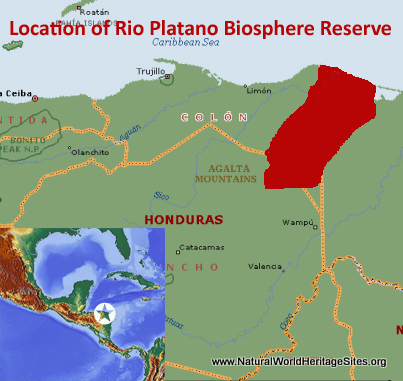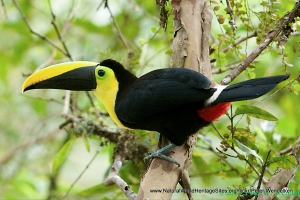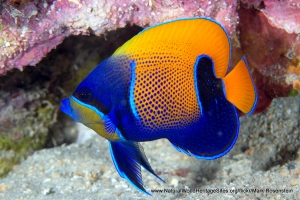EXPLORE the Rio Platano Biosphere Reserve with this slideshow, check the location map and get all the facts and information below.
For slideshow description see right or scroll down (mobile). Click to view slideshow
Location and Values: The Rio Platano Biosphere Reserve covers the entire catchment of the Platano River, from its mountainous headwaters at elevations of 1,400m to the Caribbean coast in eastern Honduras. It is an integral part of a larger conservation complex that together protects the largest contiguous forest area in Latin America north of the Amazon. The site is one of few places on the world heritage list that is recognized under all four natural criteria, with outstanding values for its scenic beauty, geological features, importance for ongoing ecological processes and biodiversity.
The Platano River is a wild river which flows freely from its mountainous headwaters to the sea. Across its catchment the reserve protects an extraordinary diversity of different ecosystems and habitats together with their inter-linked ecological processes. There are rugged granite mountain summits, remarkable rock formations, waterfalls, long stretches of white water and calmer sections where the Platano River meanders across the coastal plains with ox-bow lakes, swamps and natural levees. At the highest elevations small areas of elphin forest occur, while most of the mountain slopes are cloaked in exuberant rainforest. Along the coast there are some spectacular lagoons with major bird colonies, as well as mangrove swamps, a complex of marine and estuarine systems, seagrass beds, sandy beaches and pine savannas.
Conservation Status and Prospects. According to IUCN’s Conservation Outlook Assessment (2017) the conservation status of the Rio Platano Biosphere Reserve is ‘critical’. The site has been on the List of World Heritage In Danger since 1996 (with a short respite between 2006 and 2011) and the IUCN report notes that insecurity and lawlessness combined with a very limited governmental presence is a major concern. There are numerous serious threats to the site including (1) land clearance for agriculture and cattle ranching (associated, in some cases, with money laundering by drug traffickers) (2) illegal logging, (3) uncontrolled hunting for meat and trade in wildlife, (4) introduction of exotic species that may become invasive, and (5) plans for the construction of a series of large dams in the region. The IUCN report notes that the site’s inscription on the List of World Heritage In Danger provides a platform to draw attention to the critical situation and develop a systematic management response to the threats it faces.
Links:
Google Earth
Official UNESCO Site Details
IUCN Conservation Outlook
UNEP-WCMC Site Description
Birdlife IBA
Slideshow description
The slideshow ‘tells the story’ of the Rio Platano Biosphere Reserve with a portfolio of photos that illustrate its landscape features, human settlements and livelihoods as well as some of the typical plants and animals. It starts by illustrating a typical visitor ‘adventure’ experience to reach one of the prominent granite peaks in the core zone of the reserve. This may involve loading a vehicle on to a rather precarious-looking pontoon, followed by travel into the interior by dugout canoe, hiking and sleeping in rudimentary forest accommodation. Along the way, small villages and houses are passed and wildlife may be seen.
The second part of the slideshow illustrates the coastal zone, with its lagoons and sandy beaches where turtles nest and king vultures may be seen. This is the most heavily settled part of the reserve, where people cultivate cash crops such as cocoa as well as bananas and other food crops, while also engaging in hunting and fishing.
Throughout the slideshow, some of the typical plants and animals are shown, including (in order of appearance): scarlet macaw, white-lipped peccary, jaguarundi, Mexican spider monkey, white-throated capuchin monkey, green turtle and king vulture.
The following Flickr photographers are acknowledged with thanks for their contributions to this slideshow (as credited in the watermark of each photo): Luis Mateus , Drew Avery, Smithsonian’s National Zoo, eMammal, Rodrigo Conte, Stewart Bentley, Brian Eagar, Ricardo Kreileman, Mr Lexie, Jaime Olmo, Jeff Dyck, Richard Orr and Yochiz. Note that some of the photos of animals are from other locations and may vary slightly in appearance from individuals in the Rio Platano Biosphere Reserve.
Factfile
WORLD HERITAGE IN DANGER
(1996-2006 and 2011 to present)
Website Category:
Tropical & Sub-tropical Forests
Area: 3,500 km2
Inscribed: 1982
UNESCO Criteria:
- Outstanding natural beauty (vii);
- Geological features (viii);
- Ecological processes (ix);
- Natural habitat for biodiversity (x);
- Significant number of rare, endemic and/or endangered species (x)





